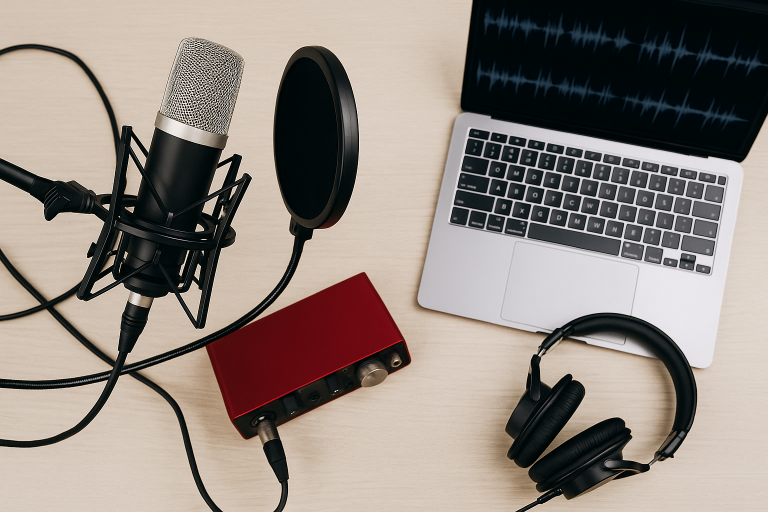
If you’ve published a book—or you’re in the process—you’ve probably heard the growing buzz around audiobooks. And it’s no surprise. Audiobook sales have been rising steadily for years, and for many readers, listening has become their preferred way to experience a story.
When I first looked into creating an audiobook, I felt overwhelmed. What gear do I need? Should I narrate it myself? How do I get it on Audible? If you’re asking these same questions, you’re not alone. So here’s a step-by-step guide based on my own research and experience to help demystify the process.
Table of Contents
- Step 1: Decide Who Will Narrate
- Step 2: Prepare Your Manuscript for Audio
- Step 3: Choose Your Equipment (If Narrating Yourself)
- Step 4: Record and Edit
- Step 5: Distribute Your Audiobook
- Step 6: Promote Your Audiobook
Step 1: Decide Who Will Narrate
Option A: Narrate It Yourself
This is a great choice if:
Your book is nonfiction or memoir and readers expect your voice.
You’re comfortable with speaking and have the time to commit.
You want full control over tone and pacing.
But narration is a real job. You’ll need a quiet recording space, good mic technique, and lots of patience. (Seriously—repeating a paragraph five times because of one breath pop is normal.)
Option B: Hire a Professional Narrator
If you want a polished, studio-quality production, this is often the best route. Sites like:
Elevenlabs
An AI voice generation platform known for its highly realistic and emotionally expressive text-to-speech technology. It allows users to create natural-sounding audio using cloned or pre-set voices, making it ideal for audiobooks, video narration, and character dialogue. Writers, content creators, and developers use it to bring their words to life with human-like vocal performance.
Step 2: Prepare Your Manuscript for Audio
Before you record or send your book off to a narrator:
Remove hyperlinks, charts, and visual references.
Replace words like “see image above” with descriptions or cuts.
Mark pronunciation guides for character names, places, or made-up words (especially for fantasy/sci-fi writers like us!).
Think of the audiobook experience as linear and auditory. You’re guiding the reader entirely by voice—so clarity matters more than layout.
Step 3: Choose Your Equipment (If Narrating Yourself)
If you’re DIY-ing your narration, you’ll need:
Microphone: USB mics like the Blue Yeti or XLR options like the Rode NT1 are popular choices.
Pop filter: Reduces harsh “p” and “s” sounds.
Audio Interface: If using an XLR mic (like Focusrite Scarlett 2i2).
Software: Free options like Audacity, or premium DAWs like Adobe Audition.
Quiet recording space: A closet with clothes or a treated room can work wonders. Reduce background noise as much as possible.
Step 4: Record and Edit
Recording takes time. Most narrators say 1 hour of finished audio = 3–6 hours of work. Be patient, hydrate, and take breaks.
If you’re editing yourself, listen for:
Background hum or hiss
Repetitive mouth noise or clicks
Pacing and awkward pauses
Not comfortable editing? You can hire a freelance audio engineer to polish your raw recordings into clean, ACX-compliant files.
Step 5: Distribute Your Audiobook
Once your files are recorded, edited, and mastered, it’s time to publish. You have two main options:
Easy to use
Royalty share or per-finished-hour pricing
Exclusive or non-exclusive options
Findaway Voices (Wide Distribution)
Reaches 40+ retailers (including Spotify, Chirp, Scribd, libraries)
More flexibility with pricing and promotions
Ideal if you’re going wide with your eBook too
Both platforms have submission guidelines, file format requirements, and audiobook cover specs (which are different from print covers—square, not rectangular!).
Step 6: Promote Your Audiobook
Now that it’s live, let people know!
Share audio snippets on social media
Add a sample to your website or newsletter
Offer free review copies through sites like BookFunnel or StoryOrigin
Run promos through Chirp (if distributed through Findaway)
Audiobook listeners are a different market—lean into that. Create content around listening habits, behind-the-scenes voice notes, or interviews with your narrator.
Final Thoughts
Creating an audiobook can feel like stepping into an entirely new creative world—but it’s one that expands your audience, breathes new life into your story, and builds deeper connections with readers (and listeners) in powerful ways.
Whether you choose to narrate it yourself or work with a professional, the key is intentionality. Know your audience, stay true to your tone, and take the time to get it right.
You’ve already written the book. Now let it speak.
